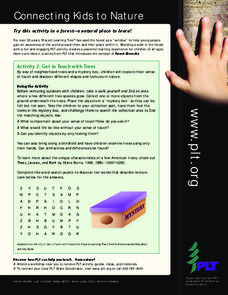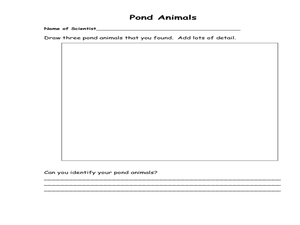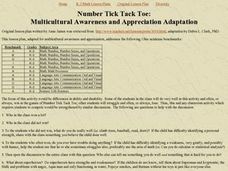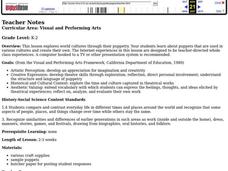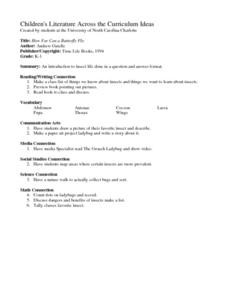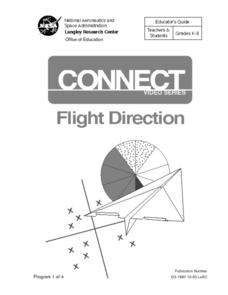Curated OER
Mud Fossils
Students create their own fossils in an activity using plaster of paris and a variety of objects which can be fossils, e.g. chicken bones, twigs, shells, etc. After making their fossils, they allow them to dry and discuss time and its...
Curated OER
Pond Exploration
Pupils take a hands-on approach to explore the world beneath the water in this activity. They examine the creatures they catch to study about the adaptations these animals have that allow them to survive in this harsh environment. They...
Curated OER
Worms in a Bottle
Students gain a better understanding of the worm and its role in the recycling of organic materials into simpler forms by constructing worm bottles and observing for 60 to 90 days.
Curated OER
Ask Jake the Sea Dog
Students access the ask-the-expert portion of the WhaleTimes.org website. They fill in the online form to submit a query of their choice and check their e-mail regularly for a response.
Curated OER
What is a Pest?
Students investigate whether rabbits should be considered pests even though they make good pets. They extend this to determine what, when, and where other organisms are considered to be pests, and examine why the concept of a pest is a...
Curated OER
Get in Touch With Trees
In this five senses worksheet, students complete several activities that help them improve their sense of touch and learn about their environment.
Curated OER
Pond and Pond Organisms
Students explore pond ecosystems. In this pond organism activity, students will use pond water and a plastic bad in order to locate and identify freshwater organisms. The activity is designed for younger grades, but...
Curated OER
Our Dinopals with WordArt
Elementary schoolers use the writing process steps to write a descriptive paragraph about a fictional dinosaur. Using a tech tool lesson, they create a graphic title for the paragraph. A nice blending of technology with "old-fashioned"...
Curated OER
How Long is a Hot Dog? Weight, Weight! Don't tell me!
Primary learners participate in activities that help them explain how different things are measured. They create their own access number chart.
Curated OER
Number Tick Tack Toe: Multicultural Awareness and Appreciation Adaptation
Students focus on this activity would be differences in ability and disability. Some of the students in the class do very well in this activity and often, or always, win in the games of Number Tick Tack Toe; other students struggle and...
Curated OER
A Teeth Changing Experience
Young scholars research human health by reading an educational story in class. In this oral health lesson, students identify the importance of brushing their teeth and consuming calcium. Young scholars read the book A Teeth Changing...
Benjamin Franklin Tercentenary
Guess What Benjamin Franklin Did!
Students research Ben Franklin's inventions. In this invention lesson, students see the relationship between a need and an invention. Students will engage in a class discussion, read a handout, and play a match the invention to its...
Curated OER
A Shadow of Yourself
Young scholars measure the length of their shadows three times during the day, Students determine the differences in shadow lengths after each measurement. They discuss why the length changed from one time of day to another.
Curated OER
PUPPETRY
Students explore world cultures through their puppetry. Your students explore puppets that are used in various cultures and create their own. The Internet experiences in this lesson are designed to be teacher-directed whole class...
Curated OER
Molly Pitcher -- "Out of Many, One"
Students research, brainstorm and analyze the events that lead up to the Revolutionary War. They critique a piece of artwork depicting a scene from the Revolutionary War. Each major battle is plotted on a map to show a visual...
Curated OER
My Feelings
First graders examine and discuss different emotions and feelings, and how people can react when they are in an unsafe situation. They discuss a feelings thermometer, and complete a worksheet involving identifying how they feel in...
Curated OER
I Think I Forgot Something!
Students examine human health by reading a children's book in class. In this breakfast lesson, students identify the importance of starting the day with a good, nutritious meal. Students read the book I Think I Forgot Something and...
Curated OER
Little Red Hen
First graders explore biology by identifying plant anatomy in class. In this botany lesson, 1st graders read the book The Little Red Hen and identify the methods used in order to grow successful plants. Students discuss other ways people...
Curated OER
Periodic Pigment
Students make paint using the ingredients from recipes from the 17th century. In this paint making lesson plan, students follow a recipe with vegetable oil, eggs, pigment, paintbrushes, and more to make their paint.
Curated OER
What are Comfortable (good) and Uncomfortable (bad) Feelings and Situations?
First graders explore and discuss how someone feels when they are not in a safe place or situation and how someone might react when put in an unsafe situation. They view a demonstration performed by puppets that express good and bad...
Curated OER
Plant a Seed of Kindness
Students perform acts of kindness. For this character lesson, students cut out seed shapes and write down their acts of kindness on them. Students place the seeds on a bulletin board where they "plant" them below the grass...
Curated OER
Children, Children, What Did You See?
Students listen to a read aloud of Brown Bear, Brown Bear, What Do You See? They write a story based on naming and drawing things they saw when they visited the Black Bayou Lake refuge.
Curated OER
How Far Can a Butterfly Fly
Students draw a picture of their favorite insect and describe. Students make a paper art project ladybug and write a story about it. Students map areas where certain insects are more prevalent. Students count dots on ladybugs and record.
Curated OER
Flight Direction
Students are introduced to NASA's Connect Series and Flight Direction programs. They explore the world of aeronautics and their missions. Students receive a front role set to the concepts and skills involved with the various NASA programs.
Other popular searches
- K 2 Life Science Growth
- K 2 Life Science Living
- K 2 Life Science Insects
- K 2 Life Science Salamander
- K 2 Life Science Hibernation
- K 2 Life Science Adaptation
- K 2 Life Science Cells
- K 2 Life Science Nonliving
- K 2 Life Science Wind





